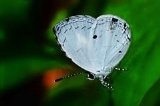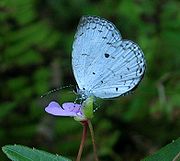
Neopithecops zalmora
Encyclopedia
The Quaker is a small butterfly
found in South Asia
and Southeast Asia
that belongs to the Lycaenids or Blues
family.

_i_img_8516.jpg)
Hind wing: discocellulars with a short brown line similar to that on the fore wing, followed by a subdorsal small round black spot, and a subcostal much larger similar spot; between these two spots is a curved, very irregular line of detached pale ashy-brown lunules; the subterminal markings very similar to those on the fore wing. Cilia of fore wing dusky brown, of hind wing white. Antenna, head, thorax and abdomen dark brown; the antenna on the inner side speckled with white; beneath; the palpi, thorax and abdomen white.
_at_narendrapur_near_kolkata_w_img_4189.jpg)
 Differs from specimens of the wet-season brood as follows:
Differs from specimens of the wet-season brood as follows:
Upperside: ground-colour not so dark generally. Fore wing: a large oval snow-white spot placed obliquely on the disc. Hind wing: apex and disc irregularly white; on the posterior half the ground-colour a shade darker than on the anterior half.
Underside: ground-colour and markings similar to those of specimens of the wet-season brood, but the markings very much paler and fainter; in specimens taken in the middle of the dry-season in exceptionally dry localities these markings are altogether absent. Antennae, head, thorax and abdomen on the upperside paler than in the wet-season brood.
; Ceylon; Assam; Burma; Tenasserim; the Andamans; extending into the Malay Peninsula
.
(Ebenaceae
) and many species of Glycosmis
(Rutaceae
) including G. arborea, G. parviflora and G. pentaphylla.
Butterfly
A butterfly is a mainly day-flying insect of the order Lepidoptera, which includes the butterflies and moths. Like other holometabolous insects, the butterfly's life cycle consists of four parts: egg, larva, pupa and adult. Most species are diurnal. Butterflies have large, often brightly coloured...
found in South Asia
South Asia
South Asia, also known as Southern Asia, is the southern region of the Asian continent, which comprises the sub-Himalayan countries and, for some authorities , also includes the adjoining countries to the west and the east...
and Southeast Asia
Southeast Asia
Southeast Asia, South-East Asia, South East Asia or Southeastern Asia is a subregion of Asia, consisting of the countries that are geographically south of China, east of India, west of New Guinea and north of Australia. The region lies on the intersection of geological plates, with heavy seismic...
that belongs to the Lycaenids or Blues
Lycaenidae
The Lycaenidae are the second-largest family of butterflies, with about 6000 species worldwide, whose members are also called gossamer-winged butterflies...
family.
Description
- See glossaryGlossary of Lepidopteran termsThis glossary describes the terms used in the formal descriptions of insect species, jargon used mostly by professionals or entomologist....
for terms used

_i_img_8516.jpg)
Wet-season form
Upperside of both sexes dark purplish brown; in the female slightly paler on the disc of the fore wing. In most specimens, but not in all, the male also has the disc of the fore wing similarly paler. Underside; white. Fore wing: apex dusky brown, apices of veins 10, 11 and 12 with a minute black dot; no discal markings, but the discocellulars picked out with a short, very slender, obscure brown line; a postdiscal, irregular, transverse series of slender brown lunules, followed by a transverse, very slender, sinuous brown line, the white ground-colour in the interspaces beyond centred by a subterminal series of transverse black spots.Hind wing: discocellulars with a short brown line similar to that on the fore wing, followed by a subdorsal small round black spot, and a subcostal much larger similar spot; between these two spots is a curved, very irregular line of detached pale ashy-brown lunules; the subterminal markings very similar to those on the fore wing. Cilia of fore wing dusky brown, of hind wing white. Antenna, head, thorax and abdomen dark brown; the antenna on the inner side speckled with white; beneath; the palpi, thorax and abdomen white.
Dry-season form
_at_narendrapur_near_kolkata_w_img_4189.jpg)

Upperside: ground-colour not so dark generally. Fore wing: a large oval snow-white spot placed obliquely on the disc. Hind wing: apex and disc irregularly white; on the posterior half the ground-colour a shade darker than on the anterior half.
Underside: ground-colour and markings similar to those of specimens of the wet-season brood, but the markings very much paler and fainter; in specimens taken in the middle of the dry-season in exceptionally dry localities these markings are altogether absent. Antennae, head, thorax and abdomen on the upperside paler than in the wet-season brood.
Distribution
India: Eastern Himalayas; Bengal: Orissa; Western GhatsWestern Ghats
The Western Ghats, Western Ghauts or the Sahyādri is a mountain range along the western side of India. It runs north to south along the western edge of the Deccan Plateau, and separates the plateau from a narrow coastal plain along the Arabian Sea. The Western Ghats block rainfall to the Deccan...
; Ceylon; Assam; Burma; Tenasserim; the Andamans; extending into the Malay Peninsula
Malay Peninsula
The Malay Peninsula or Thai-Malay Peninsula is a peninsula in Southeast Asia. The land mass runs approximately north-south and, at its terminus, is the southern-most point of the Asian mainland...
.
Food plants
The larvae are known to feed on DiospyrosDiospyros
Diospyros is a genus of about 450–500 species of deciduous and evergreen trees. The majority are native to the tropics, with only a few species extending into temperate regions. They are commonly known as ebony or persimmon trees...
(Ebenaceae
Ebenaceae
The Ebenaceae are a family of flowering plants, which includes ebony and persimmon. The family has approximately 500 species of trees and shrubs in two genera, Diospyros and Euclea. The species are mostly evergreen and native to the tropics and subtropics, with a few deciduous species native to...
) and many species of Glycosmis
Glycosmis
Glycosmis is a genus of plant in family Rutaceae.Species include:* Glycosmis crassifolia* Glycosmis decipiens* Glycosmis longisepala* Glycosmis monticola* Glycosmis perakensis* Glycosmis tomentella...
(Rutaceae
Rutaceae
Rutaceae, commonly known as the rue or citrus family, is a family of flowering plants, usually placed in the order Sapindales.Species of the family generally have flowers that divide into four or five parts, usually with strong scents...
) including G. arborea, G. parviflora and G. pentaphylla.

